Intermediate Representation(IR)
Compliers and static analyzers
编译过程:
source code
↓↓↓
scanner(lexical analysis 词法分析)--->regular expression
↓↓↓ --->Tokens
Parser(Syntax Analysis 语法分析)--->context-free grammar上下文不敏感语法
↓↓↓ --->AST 抽象语法树
Type Checker 类型检查(Semantic Analysis 语义分析)--->attribute grammar
↓↓↓ ---> Decorated AST
Translator
↓↓↓ --->IR --->Static Analysis
Code Generator
↓↓↓
machine code

编译器将源代码(Source code) 转换为机器代码(Machine Code)。其中的流程框架是:
- 词法分析器(Scanner),结合正则表达式,通过词法分析(Lexical Analysis)将 source code 翻译为 token。
- 语法分析器(Parser),结合上下文无关文法(Context-Free Grammar),通过语法分析(Syntax Analysis),将 token 解析为抽象语法树(Abstract Syntax Tree, AST)
- 语义分析器(Type Checker),结合属性文法(Attribute Grammar),通过语义分析(Semantic Analysis),将 AST 解析为 decorated AST
- Translator,将 decorated AST 翻译为生成三地址码这样的中间表示形式(Intermediate Representation, IR),并基于 IR 做静态分析(例如代码优化这样的工作)。
- Code Generator,将 IR 转换为机器代码。
AST vs. IR
AST
- high-level and closed to grammar structure
- usually language dependent (取决于不同语言)
- suitable for fast type checking
- lack of contorl flow information
IR
- low-level and closed to machine code
- usually language independent
- compact and uniform
- contains control flow information
- usually considerd as the basis for static analysis
对比:
| AST | IR |
|---|---|
| 层次更高,和语法结构更接近 | 低层次,和机器代码相接近 |
| 通常是依赖于具体的语言类的 | 通常和具体的语言无关,主要和运行语言的机器(物理机或虚拟机)有关 |
| 适合快速的类型检查 | 简单通用 |
| 缺少和程序控制流相关的信息 | 包含程序的控制流信息 |
| 通常作为静态分析的基础 |
IR冗余信息更少,包含控制流的表达,更利于静态分析
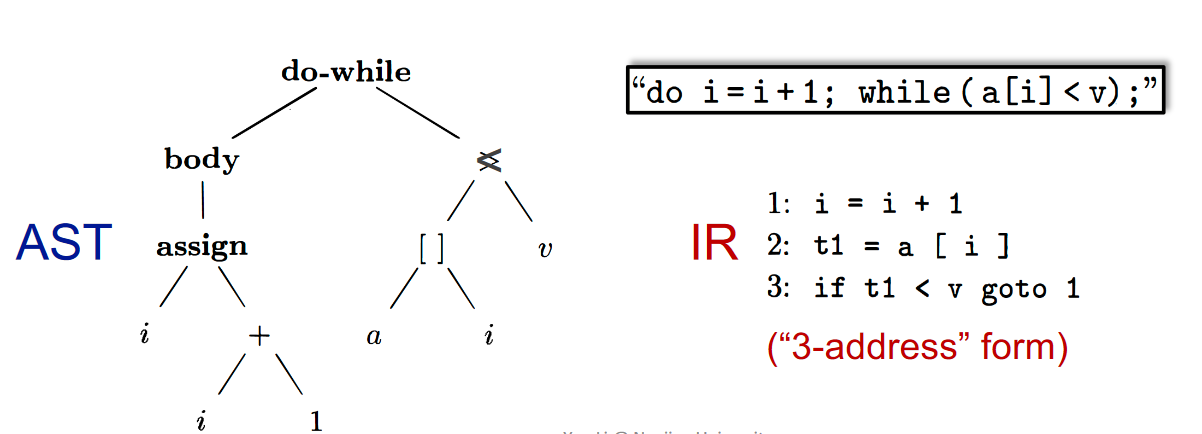
IR:Three-Address Code(3AC)
Three-Address Code(3AC)
-
There is at most one operator on the right side of an instruction
a+b+3 --> t1 = a+b t2 = t1+3
why called 3-address
-
adress can be one of the following:
- Name: a,b
- Constant: 3
- Compiler-generated temporary(编译器生成的临时量): t1,t2
each type of instructions has its own 3AC form
Some common 3AC forms
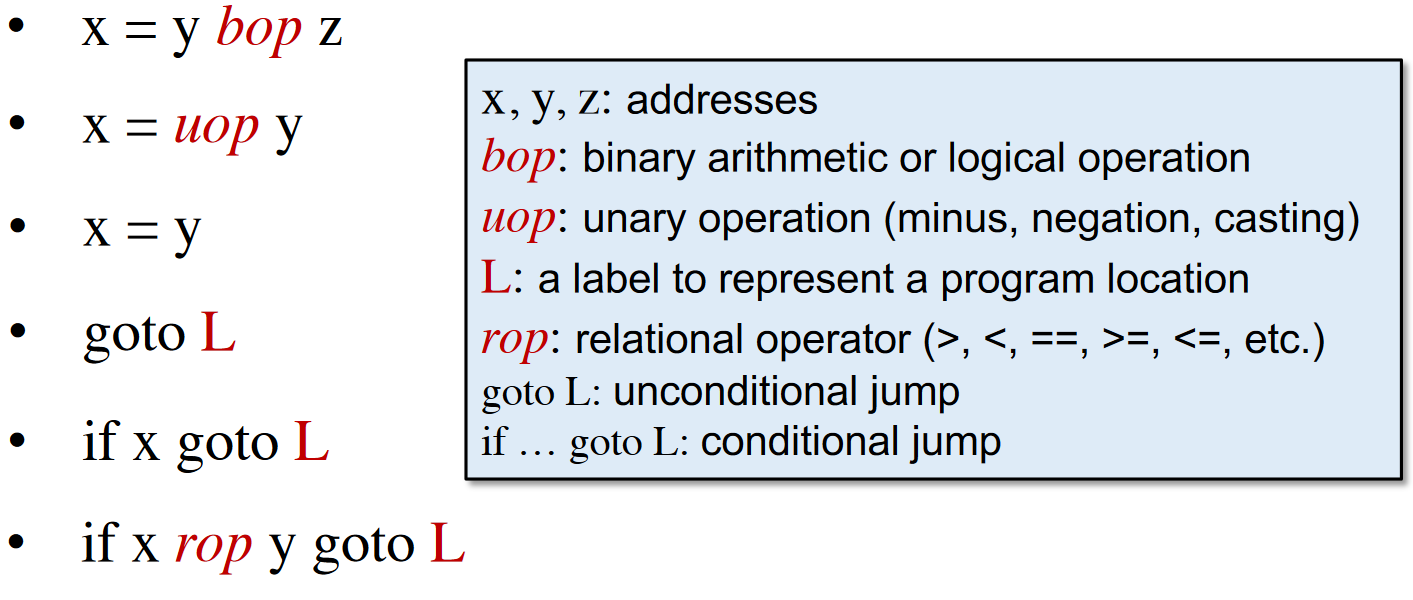
3AC in real static analyzers:Soot
Soot
- Most popular static analysis framework for Java
- Soot’s IR is Jimple: typed(类型的) 3-address code
examples
For loop:
ForLoop3AC.class
package sa.examples;
public class ForLoop3AC {
public static void main(String[] args) {
int x = 0;
for(int i = 0; i<10; i++){
x = x + 1;
}
}
}
生成ForLoop3AC.jimple:
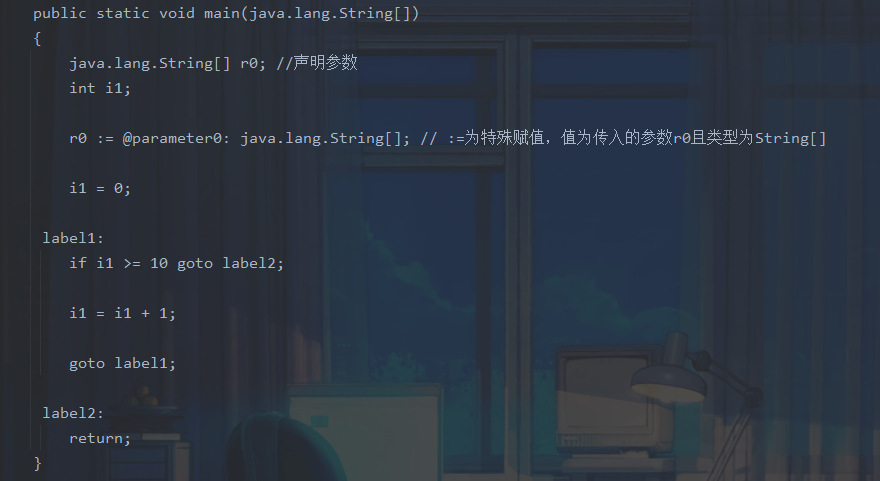
(x在之前步骤被优化掉,属于不合理优化,需要查看soot的实现)
Do-while loop:
DoWhileLoop3AC.class
package sa.examples;
public class DoWhileLoop3AC{
public static void main(String[] args){
int[] arr = new int[10];
int i = 0;
do {
i = i + 1;
} while(arr[i] == 10);
}
}
生成jimple:
public static void main(java.lang.String[])
{
int[] r0;
int $i0, i1;
java.lang.String[] r1;
r1 := @parameter0: java.lang.String[];
r0 = newarray (int)[10];
i1 = 0;
label1:
i1 = i1 + 1;
$i0 = r0[i1];
if $i0 == 10 goto label1;
return;
}
Method call:
MethodCall.class
public class MethodCall {
String foo(String para1, String para2) {
return para1 + " " + para2;
}
public static void main(String[] args) {
MethodCall mc = new MethodCall();
String result = mc.foo("hello", "world");
}
}
生成:
java.lang.String foo(java.lang.String, java.lang.String)
{
java.lang.StringBuilder $r0, $r2, $r3, $r5;
java.lang.String r1, r4, $r6;
MethodCall r7;
r7 := @this: MethodCall;
r1 := @parameter0: java.lang.String;
r4 := @parameter1: java.lang.String;
$r0 = new java.lang.StringBuilder;
specialinvoke $r0.<java.lang.StringBuilder: void <init>()>();
$r2 = virtualinvoke $r0.<java.lang.StringBuilder: java.lang.StringBuilder append(java.lang.String)>(r1);
$r3 = virtualinvoke $r2.<java.lang.StringBuilder: java.lang.StringBuilder append(java.lang.String)>(" ");
$r5 = virtualinvoke $r3.<java.lang.StringBuilder: java.lang.StringBuilder append(java.lang.String)>(r4);
$r6 = virtualinvoke $r5.<java.lang.StringBuilder: java.lang.String toString()>();
return $r6;
}

补充:
invokespecial:call constructor, call superclass methods, call private methods
invokevirtual: instance methods call (virtual dispatch)
invokeinterface: cannot optimization, checking interface implementation
invokestation:call static methods
Java 7: invokedynamic -> Java static typing, dynamic language runs on JVM
尖括号中的内容:
method signature: class name, return type, method name(parameter1 type, parameter2 type)
class:
Class3AC.class
package sa.examples;
public class Class3AC {
public static final double pi = 3.14;
public static void main(String[] args) {
}
}
生成:
public class Class3AC extends java.lang.Object
{
public static final double pi;
public void <init>()
{
Class3AC r0;
r0 := @this: Class3AC;
specialinvoke r0.<java.lang.Object: void <init>()>();
return;
}
public static void main(java.lang.String[])
{
java.lang.String[] r0;
r0 := @parameter0: java.lang.String[];
return;
}
public static void <clinit>()
{
<Class3AC: double pi> = 3.14;
return;
}
}
clinit:class类构造器对静态变量,静态代码块进行初始化,在jvm进行类加载—–验证—-解析—–初始化,中的初始化阶段jvm会调用clinit方法
Static single assignment(SSA) –optional
每次对变量x赋值都重新使用一个新的变量xi,并在后续使用中选择最新的变量

但是这样一来,肯定会因为不同控制流汇入到一个块,导致多个变量备选的问题:
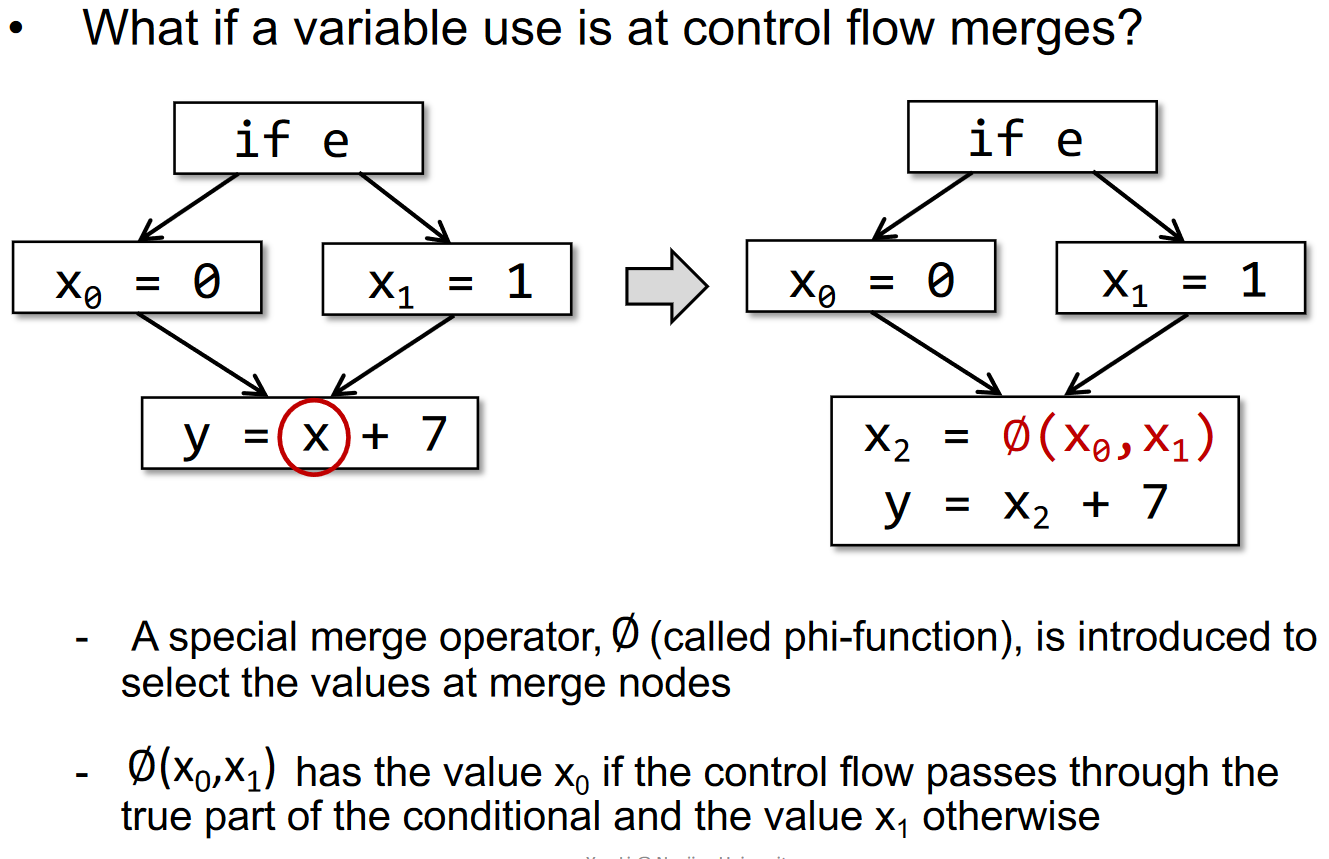
why SSA?
-
Flow information is indirectly incorporated into the unique variable names 控制流信息间接地集成到了独特变量名中
May help deliver some simpler analyses, e.g., flow-insensitive analysis gains partial precision of flow-sensitive analysis via SSA
-
Define-and-Use pairs are explicit 定义与使用是显式的
Enable more effective data facts storage and propagation in some on-demand tasks Some optimization tasks perform better on SSA (e.g.,conditional constant propagation, global value numbering)
Why not SSA?
- SSA may introduce too many variables and phi-functions
- May introduce inefficiency problem when translating to machine code (due to copy operations)
Basic Blocks (BB)
Control flow analysis
控制流分析(Control Flow Analysis)通常指的是构建控制流图(Control Flow Graph, CFG),并以 CFG 作为基础结构进行静态分析的过程。
- usually refer to building Control Flow Graphs (CFG)
- CFG serves as the basic structure for static analysis
- The node in CFG can be an individual 3-address instruction,or (usually) a Basic Block(BB)
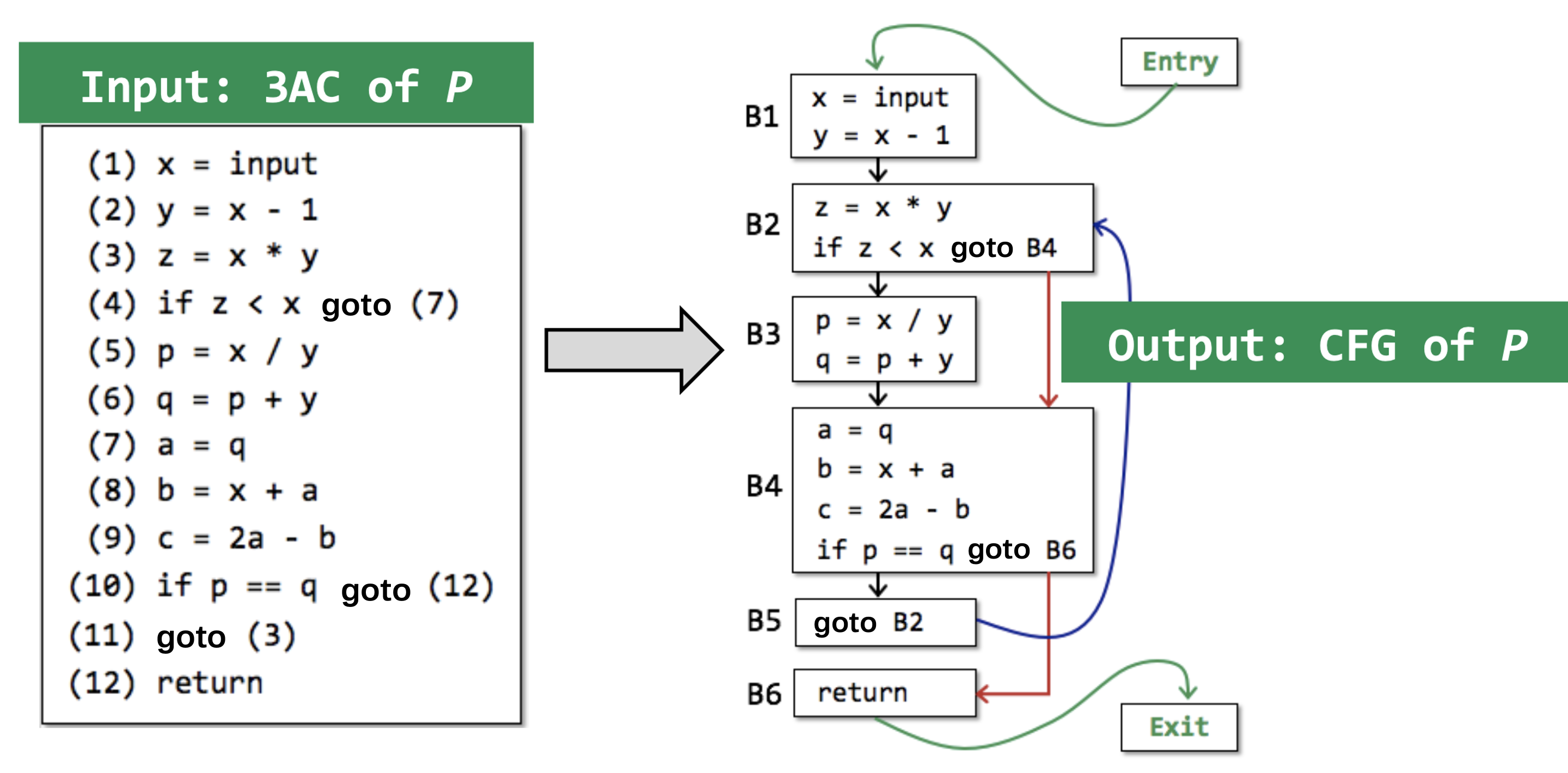
Basic Blocks (BB)
- Basic blocks(BB) are maximal sequences of consecutive three-address instructions with the properties that
- It can be entered only at the beginning,i.e.,the first instruction in the block
- It can be exited only at the end,i.e.,the last instruction in the block
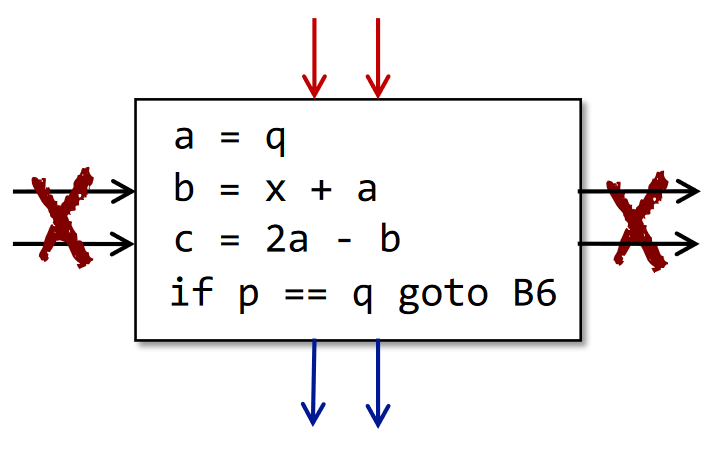
所谓基本块,就是满足以下性质的连续 3AC:
- 只能从块的第一条指令进入。
- 只能从块的最后一条指令离开。
Build BBs
-
input: a sequence of three-address instructions of P
-
output: a list of basic blocks of P
-
method:
-
determine the leaders in P
- the first instruction in P is a leader
- any target instruction of a conditional or unconditional jump is a leader
- any instruction that immediately follows a conditional or unconditional jump is a leader
-
build BBs for P
- a BB consists of a leader and all its subsequent instructions until the next leader
-
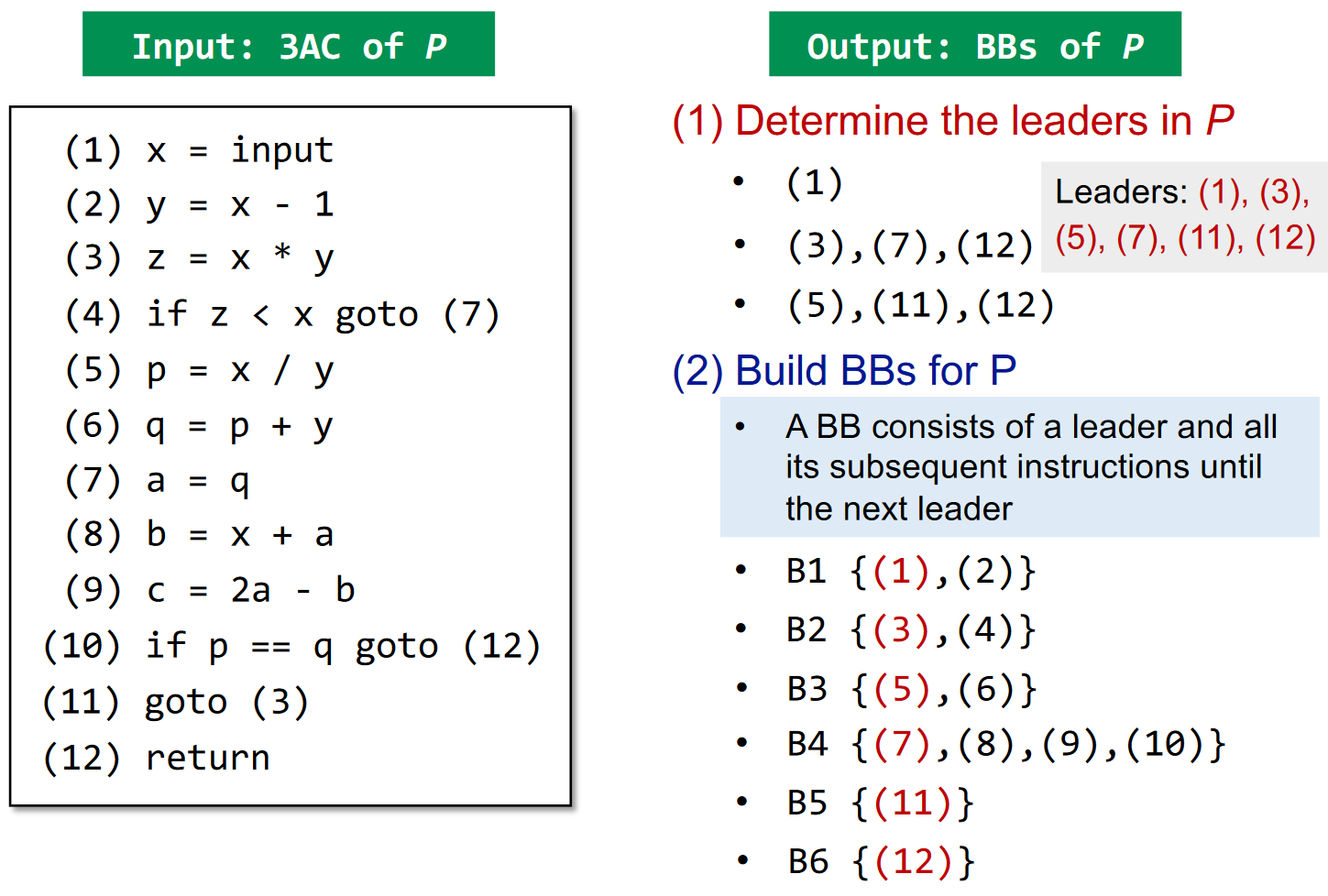
Control Flow Graphs (CFG)
-
The nodes of CFG are basic blocks
-
There is an edge from block A to block B and only if
- There is a conditional or unconditional jump from the end of A to the beginning of B
- B immediately follows A in the original order of instructions and A does not in an unconditional jump
-
It is normal to replace the jumps to instruction labels by jumps to basic blocks

example:
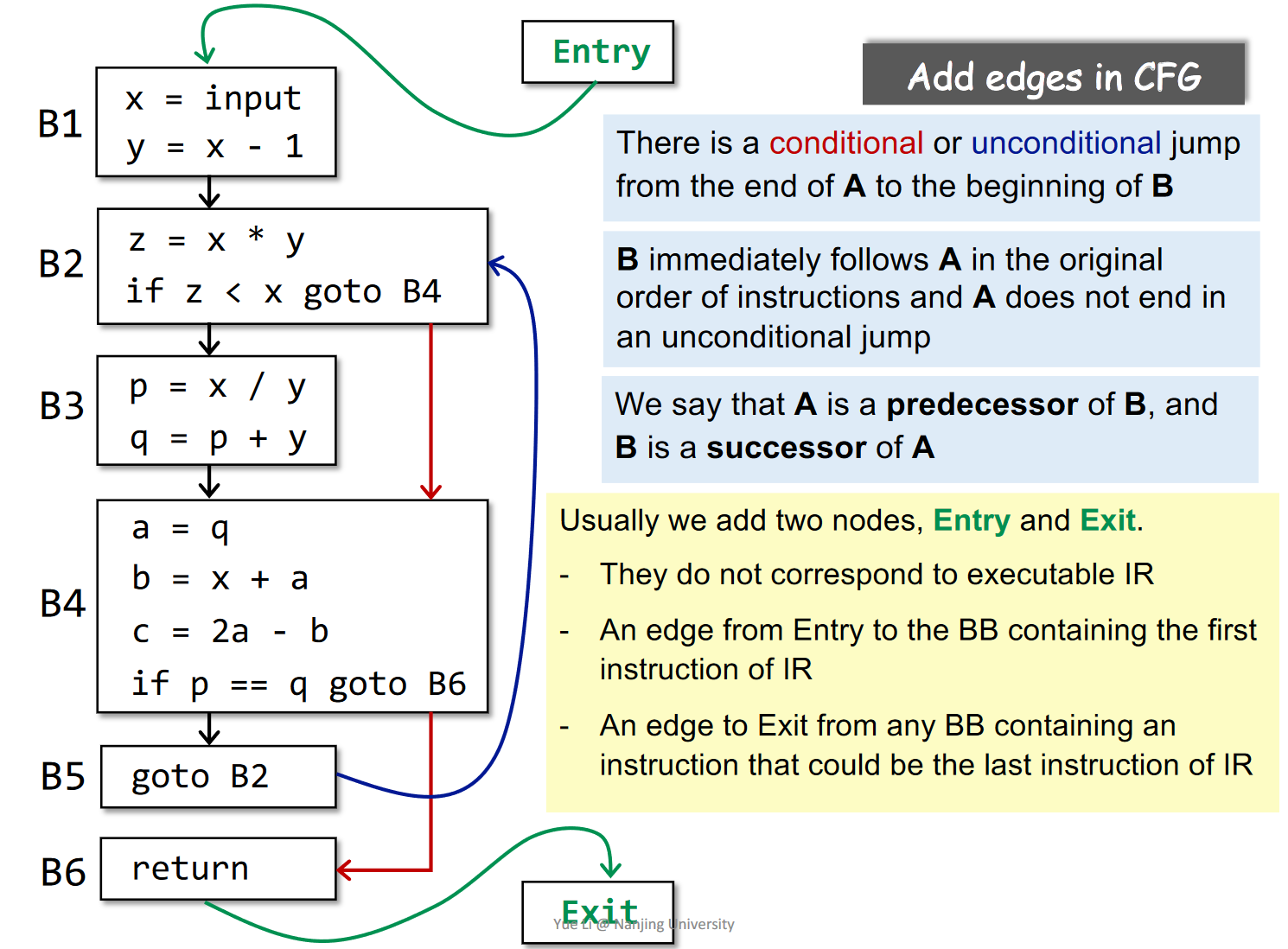
- 若 A -> B,则我们说 A 是 B 的前驱(predecessor),B 是 A 的后继(successor)
- 除了构建好的基本块,我们还会额外添加两个结点,「入口(Entry)」和「出口(Exit)」
- 这两个结点不对应任何 IR
- 入口有一条边指向 IR 中的第一条指令
- 如果一个基本块的最后一条指令会让程序离开这段 IR,那么这个基本块就会有一条边指向出口。
Self test
-
The relation between compilers and static analyzers
静态分析器基于编译器处理好的IR进行分析
-
Understand 3AC and its common forms
三地址码,在每个指令的右边至多有一个操作符。
常见形式:
- x = y bop z:双目运算并赋值,bop = binary operator
- x = uop z:单目运算并赋值,uop = unary operator
- x = y:直接赋值
- goto L:无条件跳转,L = label
- if x goto L:条件跳转
- if x rop y goto L:包含了关系运算的条件跳转,rop = relational operator
-
How to build basic blocks on top of IR
- 输入:程序 P 的一系列 3AC
- 输出:程序 P 的基本块
- 方法
- 决定 P 的 leaders
- P 的第一条指令就是一个 leader
- 跳转的目标指令是一个 leader
- 跳转指令的后一条指令,也是一个 leader
- 构建 P 的基本块
- 一个基本块就是一个 leader 及其后续直到下一个 leader 前的所有指令。
- 决定 P 的 leaders
-
How to construct control flow graphs on top of BBs?
-
加边,块 A 和块 B 之间有一条边,当且仅当:
- A 的末尾有一条指向了 B 开头的跳转指令。
- A 的末尾紧接着 B 的开头,且 A 的末尾不是一条无条件跳转指令。
-
添加入口和出口
-
Conclusion
本节课学习了IR的定义以及CFG的构建,即
AST-->IR(3AC)-->BBs-->CFG
之后我们基于CFG进行进一步的静态分析